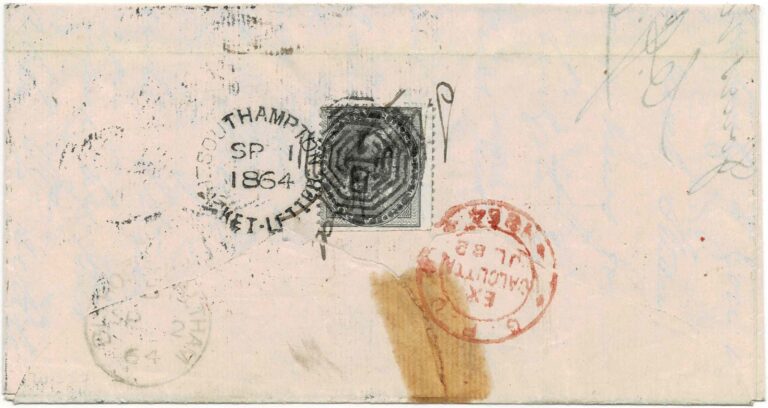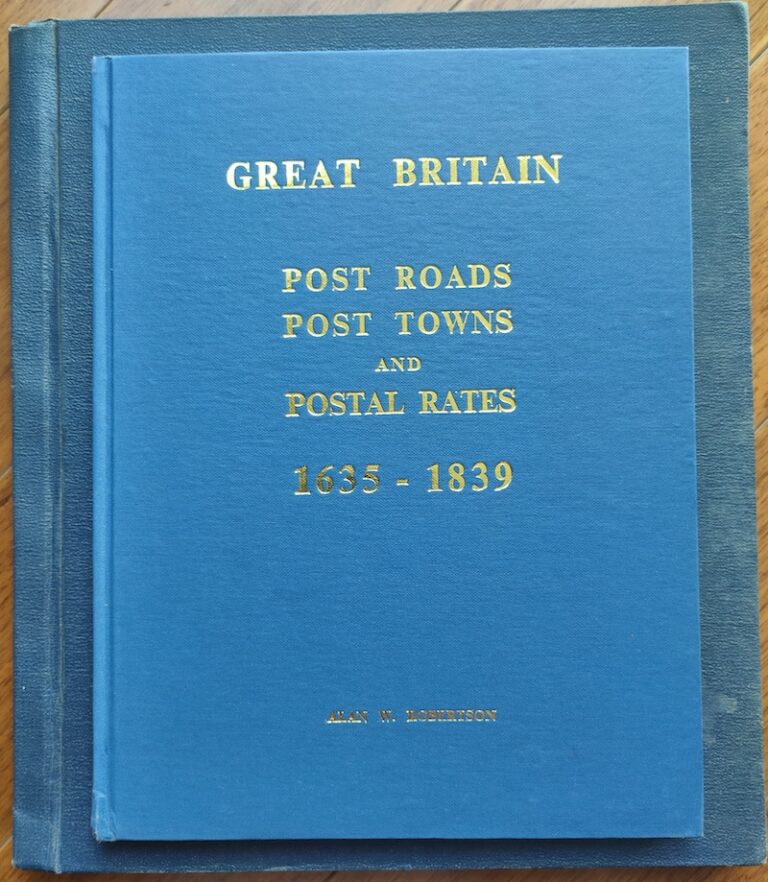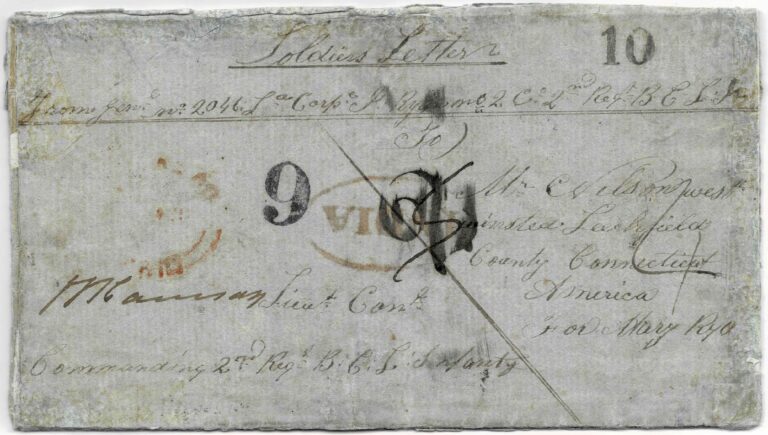Figure 1 shows an entire (ex-Paul Bulterman) sent from Boxtel, Netherlands to Batavia, Dutch East Indies sent in November 1845. Fragile yet beautiful with various rate marks and handstamps, the letter shows the intended routing at the bottom: “via Marseille / Alexandria / Singapore”.

The black borders indicate death and/or mourning. Unable to read the writing, I put up my query on Twitter which brought out this response:
and this…
Why do I call the letter a “Perfect 10”? Well, it ticks (and ticks in style) all the three boxes important in a postal history item – routes, rates, and modes of carriage (of which six of them were in steamers of various hues and sizes!) Let me explain them in detail; it really is fascinating. So, grab a cup of steaming coffee and hang on; this is going to a longer-than-usual ride!
The ‘China Line’
Before we look at the route taken by the letter, a few lines on the Peninsular and Oriental Steam Navigation Company‘s (P&O) ‘China Line’! This line connected the Far East and Europe and started operations in July 1845. Steamers connected Galle-Penang-Singapore-Hong Kong (9-12-13-14 in Figure 2) initially.

Now the benefits of the ‘overland’ route was made available to individuals and merchants at places touched by this line. And places not too far away like Batavia (Dutch East Indies) and Manila (Philippines). Rather than shipping their correspondence across the Cape on slow sailing vessels or trans-shipping to Bombay to catch the East India Company’s steamers to Suez, the China Line helped compress the time taken for letters to travel East-West.
Stage 1: Boxtel to Amsterdam (overland)
Written at Boxtel, a town in southern Netherlands, the letter is datelined 24 October (on first page) as well as 22? November 1846 (its reverse). This was quite usual for merchant correspondence when the first dateline and the contents that followed were the duplicate of an original sent earlier. The second dateline and the contents below it would typically be the original. On the other hand, if it was a personal correspondence, senders would write some one day and some more some other day; remember, when postage was quite expensive then.
There are no postmarks of Boxtel. So, I presume the letter was carried under cover or per favour to Amsterdam where it was posted (I can claim no mastery of European postal history and comments are welcome). The letter was charged 210 Dutch cents (top left) as postage as the blue handstamp ‘P.P.’ (center) attests. Note that this does not mean the letter paid the rate all the way to Batavia; but only to Alexandria.
Stage 2: Amsterdam to Marseilles (overland)
The letter was sent across Belgium and France to the port city of Marseilles. It passed via Valenciennes in France where the red entry postmark ‘PAYS-BAS / 25 / NOV. / 30? / 1 VALNES 2′ (like Van der Linden 2181/2182) was applied. Onward to Bayonne (28.11; see datestamp) and finally Marseilles (30.11; another datestamp).

Now, I will go back to the 210 Dutch cents that was charged at Amsterdam. As one can see (Figure 3), the numbers ‘70’ and ‘140’, shown as 70/140, which add up to ‘210’, are written next to the latter number. There is also a ‘10’ which I believe was noted in Amsterdam (and not Singapore) and which implies that the letter weighed 10 gm. At this point in time, 10 gm implied ‘2 rates’; in other words, this was a double letter.
The rate charged to the sender can be explained as follows:
- Amsterdam to Breda to Bergen: 35 cents x 2 = 70 cents
- Valenciennes to Marseilles to Alexandria: 70 cents x 2 = 140 cents
- Total 210 cents
These rates come about as a result of postal conventions between Netherlands / Belgium / France. I prefer relying on primary sources but since I don’t read the languages they are in, I find it difficult to study them as much as I would like. So I relied on Delbeke (1998) for the rate analysis; the book on my lap and a mobile running a language translation app in my hands!
Stage 3: Marseilles to Malta (HMS steamer)
At Marseilles, the letter was put on Great Britain’s (GB) admiralty steamer – HMS Acheron – which journeyed from Marseilles (13.12) to Malta (17.12). At this time, the Marseilles-Malta route was operated by HMS steamers and not by those of the P&O.
How could Dutch letters be put on board British contract steamers? Well, this is because GB and France had executed postal conventions with each other (the latest being the 1843 Anglo-French convention) as had France and Netherlands. Under the terms of conventions, the cost of shipping due would pass from Netherlands to France to Britain.
There is also the possibility of the letter being carried by French packet to Alexandria. Either on the Louqsor from Marseilles (4.12) to Malta (7.12) to Beyrouth (18.12) to Alexandria (20.12) or on the Alexandre: Marseilles (5.12) – Alexandria (17.12). Both would have arrived at Alexandria before the Iberia (see next).
Stage 4: Malta to Alexandria (P&O packet steamer)
If we assume that the letter was carried by British packet from Marseilles to Malta, the Malta (17.12) to Alexandria (21.12) leg was performed by the P&O Iberia.
Stage 5: Alexandria to Suez (‘overland’ route)
The overland route across Egypt is rightly thought to have revolutionised East-West communications. The route connected Alexandria at the north-west part of Egypt with Suez in the south-east. The distance between the two ports was about 250 miles. It comprised of the following stages:
- Alexandria to Afteh mostly on the Mahmoudieh Canal: 44 miles
- Afteh to Boulac on the river Nile: 120 miles
- Boulac to Cairo: 2 miles
- Cairo to Suez on camels across the desert: 84 miles
It was gruelling across this route, especially for passengers. Only by 1859 did the railways connect Alexandria and Suez thus making the journey quicker and more comfortable.

Stage 6: Suez to Bombay (EIC packet steamer)
At Suez, the letter should have been out on board one of the steamers of P&O’s ‘Calcutta Line’. The Calcutta Line went from Suez to Calcutta (about 4,635 miles) with stops at Aden, Galle in Ceylon, and Madras (5-6-9-10-11 in Figure 2). The mails for the Far East would have been offloaded at Galle to connect with the China Line. However, likely by mistake or by habit, the letter was sent to Bombay (5-6-7 in Figure 2) on the East India Company’s (EIC) steamer Acbar. The route: Suez (25.12) to Bombay (8.01.1846) via Aden (31.12).
Stage 7: Bombay to Colombo (Ceylon government steamer)
At Bombay, the handstamp ‘BOMBAY / JA 8 1846 / STR. POSTAGE {8} / INLD. Ship DO. {2}’ (Giles SR6; ‘Ship’ overwritten on top of INLD.) was applied (the day looks like a ‘3’ but must be an ‘8’) (Figure 5) Basically, ‘8’ implies that the letter was assessed to pay eight annas (one anna was equal to one-and-half pence and hence eight annas was the equivalent of one shilling) steam postage for the Alexandria-India carriage. The Bombay post office also recognised that the letter needed to be connected outwards such that it could reached Galle to further connect with P&O’s contracted steamers; there being no packets which operated between Bombay and Galle at this time. This entailed outgoing ship postage of ‘2’ for two annas (per three tolas; one tola being about 0.4 ounces).
Since the post office didn’t have a handstamp for this kind of unusual happening, they used an existing ship receipt handstamp, overwriting INLD. with ‘Ship’!

Where is the Forwarding Agent
But who paid this charge of ‘10’ annas? There is no forwarding agent’s name mentioned on the cover; why would there be since this letter was never meant to be routed via Bombay? If there was no name, who could the post office collect the 10 annas from? The choice between the post office lay between detaining the cover indefinitely or letting the cover carry on its journey. Happily, for the recipient and us postal historians, the Bombay post office chose the latter!
Steamer Seaforth
How did the letter go to Galle? On the Ceylon Government’s steamer Seaforth (Figure 7). She sailed out of Bombay (9.01) the next day but I haven’t been able to trace when she reached Colombo. There aren’t many covers, if any at all, positively identified as being carried by the Seaforth from Bombay to Colombo but this is one of them.

The story of the Seaforth is interesting enough that I need to write a bit about her (unfortunately I haven’t been able to find any pictures). She was a steamer of 300 tons with engines of 30 hp built at Bombay. Purchased by the Ceylon government in October 1840, she was intended for service in the pearl banks. In 1841, as there appeared to be no prospect of revenue from pearl fisheries for several years to come, Seaforth was reengaged as a packet to carry mails between Colombo and Bombay to connect with the overland steamers from Bombay. She also carried mails from Europe, which had reached Bombay, to Ceylon. Like this one.
Stage 8: Colombo to Galle (overland)
Post offices were established in both Colombo and Galle as far back as October 1798, if not earlier. While both towns are port cities in the south-west of Ceylon, I would think that the letter would have gone overland (about 70 odd miles) and not by sea.
Stage 9: Galle to Singapore (P&O packet steamer)
At Galle, the letter was put on the next steamer of the China Line – P&O Lady Mary Wood (Figure 6). Her route was Galle (28.01) – Penang (7.02) – Singapore (8.02).
Incidentally, it was the LMW which had inaugurated the China Line when she sailed out of Galle on 27 July 1845. She and P&O Braganza were the only two steamers on this line until mid 1847, after which larger and more powerful steamers were deployed by the P&O.

Stage 10: Singapore to Batavia (ZMS steamer)
At Singapore, the post office applied the scarce ‘SINGAPORE / SHIP LETTER / 1846 Feb / Bearing’ (Proud SL1) handstamp. Even though the letter was carried by a packet steamer and not a ship. As I have mentioned before, I don’t think that the ’10’ close to this handstamp is a reiteration of the 10 (8+2) annas postage due that Bombay mentioned; rather it implies 10 gm and was superscribed in Amsterdam. The ink of it is exactly the same as that of ‘70’, ‘140’, and ‘210’ (Figure 3).
At Singapore, the Dutch war ship ZMS (Zijner Majesteits) Bromo had been waiting for four days to take the overland mails to Batavia. Bromo left Singapore (9.02) the next day reaching Batavia (12.02) three days later. The recipient’s docketing inside confirms that they received the letter that day.
It is interesting to note that, due to lack of connections at Suez, even if the letter was sent correctly to Galle rather than to Bombay, it would have made no difference to the recipient; they would have received the letter on 12 February either way. However, we wouldn’t have had as interesting a story as we have now!
This is not the end though. At Batavia the recipient had to pay 216 copper duiten as postage on this letter. This amount, which was written in black as ‘216’ just above the address, is broken up as below:
- Alexandria to Singapore: 2 shillings 2 pence due to GB / East India Company or 130 Dutch cents (one pence was equal to five cents)
- Singapore to Batavia: Dutch sea postage of 50 cents
- Total 180 Dutch cents or 216 copper duiten (one cent was 1.2 duiten)
Conclusion
Postal history of international mails fascinates me. Until recently (or even into this day), postal historians have only studied ‘their part’ of an item i.e. the part(s) that they understood, leaving other, more difficult, aspects aside.
For instance, in the case of this letter, a Dutch collector will typically understand the significance of ‘210’ and the ‘216’ (Figure 8). But will struggle with the ‘8’ and the ’2’. An Indian collector, on the other hand, will know what the latter mean but will be clueless about the other numbers.

I don’t doubt that it is a difficult task to figure out everything about many postal history items, whether they belong to the classic period or even the modern post-World War II one. However, in recent times, with the publication of so many wonderful postal history books and with the help of all the information on the internet, I think that we are much better placed than ever, to study and understand ‘all parts’ of a postal history item. So, shouldn’t we?
And finally, shouldn’t postal historians from both sides of the divide collaborate with each other rather than being content with understanding what they are comfortable with?
References
- Delbeke, Claude J.P. De Nederlandse Scheepspost. I. Nederland – Oost-Indië 1600-1900. Met Catalogues van de Stempels. (=The Dutch Ship Post. I. The Netherlands – East Indies 1600-1900. With Catalogs of the Stamps.). Aalter, Belgium: The Author, 1998
- Giles, D. Hammond. Catalogue of the Handstruck Postage Stamps of India. London: Christie’s Robson Lowe, 1989
- Kirk, R. The P&O Lines to the Far East. Vol. 2. 4 vols. British Maritime Postal History. Heathfield, East Sussex: Proud-Bailey Co. Ltd., 1982
- Linden, James Van der. Catalogue / Katalog Marques de Passage / Postvertragsstempel Katalog 1661-1875 (= Catalogue of Marks of Passage / Postal Stamps). Luxembourg: Soluphil, 1993
- Proud, Edward B. The Postal History of Malaya Vol 1. 2nd ed. Vol. I. III vols. Heathfield, East Sussex: Proud-Bailey Co. Ltd., 2000
- Salles, Raymond. La Poste Maritime Française. Tome II. Les Paquebots de la Méditerranée de 1837 à 1939. (=The French Maritime Post. Volume II. The Ships of the Mediterranean from 1837 to 1939.). Vol. II. IX vols. Encyclopédie de la Poste Maritime Française Historique et Catalogue. Paris: The Author, 1962
- Tabeart, Colin. Admiralty Mediterranean Steam Packets 1830 to 1857. Limassol, Cyprus: James Bendon Ltd., 2002
- Tristant, Henri. Les Lignes Regulières De Paquebots-Poste: Du Levant Et D’Égypte 1837 – 1851 (=The Regular Lines of Packet Posts: From the Levant and Egypt 1837 – 1851). Paris: The Author, 1987







